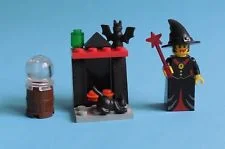A COMMON ENCHANTMENT - Tyler McCabe
When I was ten years old, I told my little sister that a witch lived in our fireplace.
“Don’t tell mom. Here—listen,” I said, pointing to the brick façade. Outside, the wind flying over the chimney created a sighing sound.
Her eyes widened. “She’s sleeping.”
I told her the witch couldn’t get out as long as she kept the secret, mainly so I’d stay out of trouble for “scaring my sister.” She stifled a laugh and tapped at the brick. At that age, you get lost in your own fables: when she swore to keep the witch secret, I started believing the witch might one day wake up.
Today, my sister is a nurse. We don’t talk about witches anymore, or enchanted fireplaces that bind them. She works in medicine and I work in data analysis, and those sorts of conversations seem to belong to a fairytale book we threw out a long time ago.
We were raised by a medical editor, under the watchful care of her diagnoses and knowledge of Western medicine. When our throats burned, we didn’t swallow cayenne and honey, but ibuprofen. When we saw friends eating vitamin C like candy to prevent a cold, we cast knowing glances at each other, reminding ourselves the body can’t absorb extra vitamin C that quickly. And later, when the twin vines of our development both took a turn away from the sun, when we began to each experience some form of generalized anxiety, we twined closer, noting that familial love by all accounts alleviates certain symptoms.
Now I send a text message reminding her of the witch. Outside, it’s wintertime and the night is growing longer. My stomach is talking. I ask her if she wants to catch a bite. All down the street, I’m watching lights float up from the deep like little fish in a net. I can’t roll my eyes at fairytales while I still speak in magical terms.
She texts back and I laugh. I can hear her laugh inside mine, which nobody would consider paranormal, but probably should. I have been rereading a book called Science Set Free, in which scientist Rupert Sheldrake carefully points out the gaps in our scientific understanding today. It’s thrilling. He means to inspire a new generation of scientific inquiry and new ways of thinking about how even the most common phenomena arise. For example, I would’ve thought the anxiety my sister and I share could be explained by genetic science, but the evidence just isn’t there.
Sheldrake asserts that certain scientists’ “faith in the predictive power of the genome is misplaced because genes enable organisms to make proteins, but do not explain the development of embryos.” He explains how proteins are made according to genetic patterns, but how each protein folds in a specific way to create a structure for a unique purpose, and how genes have apparently nothing to do with that folding process, nor their eventual purpose. After more than forty years of intensive, well-funded research, scientists can still only describe how “cells, tissues, and organs develop in a modular manner, shaped by morphogenetic fields.” In other words, why do proteins in development become at the right moment a heart and not a liver? There is no widely held theory.
In the absence of evidence, the vocabulary we use to talk about genes starts coming to life: we speak incorrectly of genes molding or creating form, controlling or directing habits, or we attribute motives like selfishness to them. It starts to sound as if genes are witches casting spells.
“Never before has the gap between the quantity of information and our ability to interpret it been so great,” stated Francis Collins, former head of the Human Genome Project, in a 2009 paper in Nature. Despite billions of dollars in research, genetic science is still riddled with interesting questions and confounding bits of information. Gene quantity appears to have no relationship to the complexity of an organism: a fruit fly has more genes than a human. Rice has more genes than a human. Roughly fifty human genes associated with height, taken together, only seem to account for about five percent of the inheritance of height. And as Sheldrake notes, “Many other examples of missing heritability are now known, including the heritability of many diseases, making ‘personal genomics’ of very questionable value. Since 2008, in scientific literature this phenomenon has been called the ‘missing heritability problem.’”
We know so little yet we speak so calmly. I go about my day. It remains that siblings share gifts and afflictions regardless of my comprehension. I text my sister. I do not think about these common enchantments. It almost seems not to matter if there is a solid, demonstrable explanation for what my sister and I share. What does it matter? What would it gain me? Our healing is not in the explanation, but the story we are telling each other.
As in, once upon a time, a witch slept in a fireplace.
She snored softly through the winter.
One evening, a pair of foolish siblings playing nearby managed to wake her, and when they woke her she was very unhappy. She rose from her rocking chair, howled at the children, and dispersed into shadow. She vowed to follow the siblings all the days of their lives, to sew doubt into their joy and worry into their triumph.
There was nothing the siblings could do. They locked hands. They looked down and saw that their shadows, too, had joined.
Each looked into the other’s face and understood.





